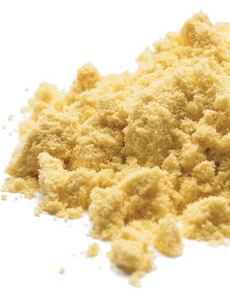

Creole mustard and shrimp. Photo courtesy McCormick.
March 2006
Last Updated May 2012
|
 |
Mustard Type Glossary
Page 3: Types Of Mustard ~ C & D
This is Page 3 of a seven-page glossary. Click on the black links below to visit other pages. If you’d like to suggest additional words for inclusion, click here. See our many other food glossaries.
CHINESE MUSTARD
A very hot prepared mustard made from brown mustard seeds, instead of the more mild white mustard seeds. The Chinese mustard served by North American Chinese restaurants can be approximated by Colman’s Mustard (see below).
COGNAC MUSTARD or MOUTARDE ROYALE
Any style mustard can be flavored with cognac to create a rich and sophisticated garnishrich and sophisticated garnish. Moutarde de Meaux, or whole-grain mustard, flavored with cognac is called Moutarde Royale.
|
|

You can purchase a crock of Moutarde Royale, which is Moutarde de Meaux, the “king of mustards,” flavored with Cognac. |
COLMAN’S MUSTARD
The leading brand of English mustard founded by Jeremiah Colman, originally a flour miller (as were the French brothers, Americans who created French’s mustard). Similar to Chinese mustard.
CREAMY MUSTARD
While this term refers to a non-grainy mustard, it can also specify a mustard to which butter and eggs are added.
CREOLE MUSTARD
Originally, a pungent style made from brown mustard seeds marinated in vinegar, ground and mixed with a hint of horseradish to create a hot, spicy mustard. Today, some products labeled “creole mustard” are sweet-style mustards made with molasses. |
|

You can purchase Colman’s Mustard, a
superfine mustard powder that creates a hot mustard. By appointment to Her Majesty the Queen.
|
DELI MUSTARD
A brown mustard seasoned with garlic, dark brown sugar, ginger, allspice and cinnamon. Flecks of spice dot the mustard.
DIJON MUSTARD
Dijon, in the province of Burgundy, France, has been a gourmet center since early times. The mustard developed there was based on particularly strong and piquant mustard seeds grown in the chalky soil and densely wooded terrain. The seeds were carefully selected and harvested on sites that were rich in potassium and carbon. Today’s Dijon is not the original product developed in monasteries: in 1856 Jean Naigeon, a local producer, revived the flagging industry by substituting verjus for vinegar and creating a smoother, less biting product (today, white wine is most often used). Today's product is also made with brown mustard seeds instead of black, owing to the difficulty of growing the latter. While Dijon mustard was the first to be regulated, it is not covered by a Protected Designation of Origin (PDO) or a Protected Geographical Indication (PGI) under the auspices of the European Union. Thus, while there are large mustard plants in Dijon and its environs, most Dijon mustard is Dijon-style, manufactured outside of Dijon.
DIJON-STYLE MUSTARD
A mustard made in the style of Dijon mustard but not made in Dijon, France.
|
|

Dijon mustard is made in both whole-grain and smooth preparations, like these artisan, stone-ground mustards from Ritz Escoffier, selected by the Paris Ritz Hotel.

|
DRY MUSTARD
Dry mustard is a powder made by grinding mustard seeds. It can be used as an ingredient in a marinade, rub or other recipe; or it can be reconstituted into prepared mustard with the addition of a liquid: beer, grape must, vinegar, water or wine.
DÜSSELDORF MUSTARD
A spicy traditional German mustard, dark in color, made with brown mustard seeds, sometimes with horseradish. It is a hot and pungent version of Dijon-style mustard. It is usually served with sausages and cold meats. You can buy it online. |
|

Dry mustard is simply ground-up mustard seed. |
Continue To Page 4: Mustard Types Beginning With E To G
Go To The Article Index Above

|









